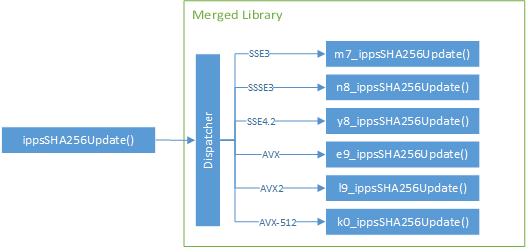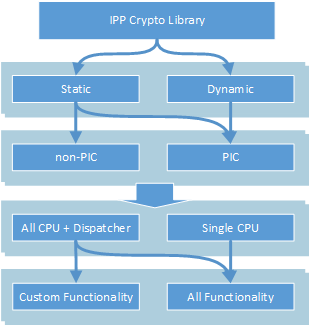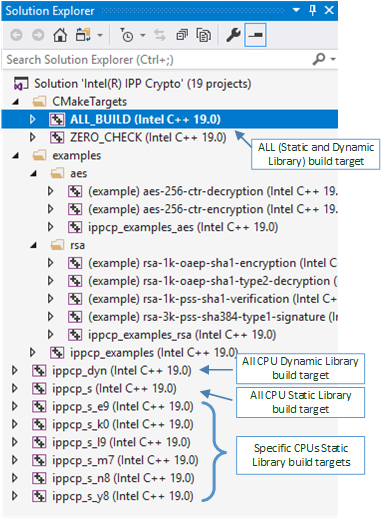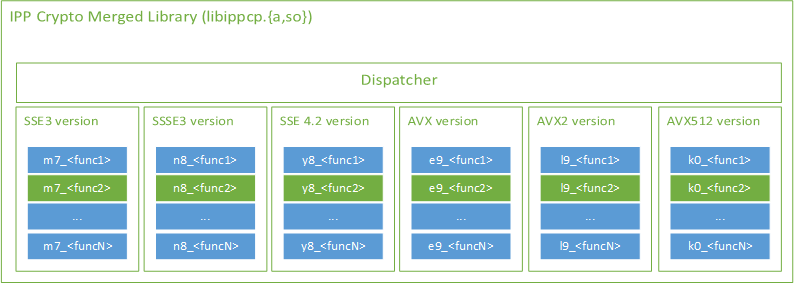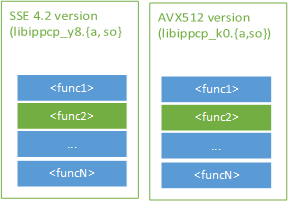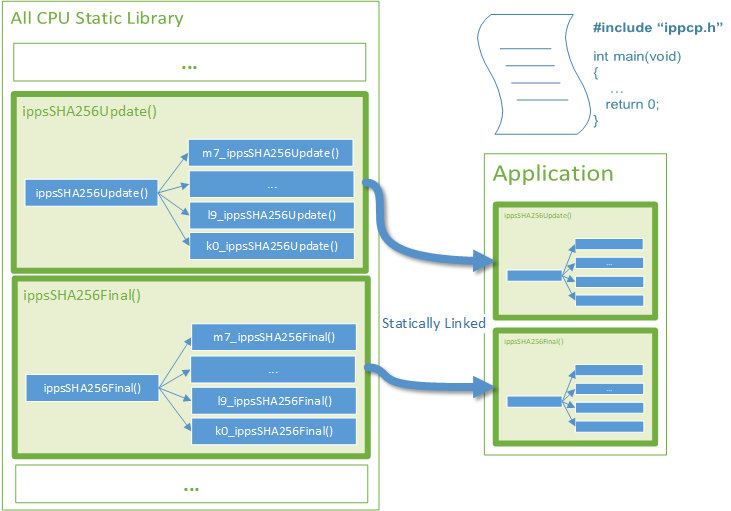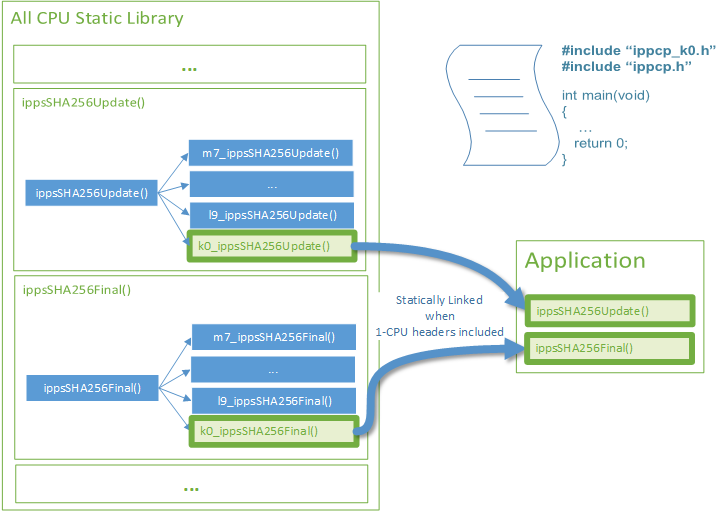14 KiB
Intel® Integrated Performance Primitives Cryptography (Intel® IPP Cryptography) Library Overview
Repository Structure
├── CHANGELOG.md
├── CMakeLists.txt < Main CMake file
├── examples < Examples of the library usage
├── include < Public headers
├── LICENSE
├── README.md
├── sources
│ ├── cmake < OS-specific CMake files
│ │ ├── linux
│ │ ├── macosx
│ │ └── windows
│ ├── dispatcher < CPU dispatcher generator
│ ├── gen_cpu_spc_header < Single CPU headers generator
│ ├── include < Internal headers
│ └── ippcp < C-sources
│ ├── asm_ia32 < IA-32 Assembler sources
│ ├── asm_intel64 < Intel® 64 Assembler sources
│ └── ifma_rsa_mb < Sources of RSA IFMA Multi-buffer library
└── tools
└── ipp_custom_library_tool_python < Custom Library Tool
Branches Description
develop- snapshots of the library under active development. Contains code that may not be fully functional and that Intel may substantially modify in development of a production version.ipp_crypto_<release>- source code of the official production release<release>.
Dispatcher
CPU Dispatching
For the best performance, Intel IPP Cryptography uses multiple implementations of each function, optimized for various CPUs, and the library version targeted for any CPU contains all of these implementations.
With the dispatcher, the library detects an available CPU in a runtime and chooses the best for the current hardware version of a function. The process of dispatching is transparent and you can always call a generic function as illustrated at the picture below.
The prefix before the function name ("m7_", "n8_", etc) is a naming convention for the function implementations that are included in the library with dispatcher. It refers to the CPU instruction set for which the function is optimized (for all available prefixes see the table below).
The dispatcher is designed to add no performance overhead when the library is initialized, in other words, when CPU features are detected. You can initialize the library either explicitly in advance by calling the dedicated function ippcpInit() or it will be done implicitly during the first call of any function of the library.
By default, the dispatcher chooses the most appropriate optimization for the current hardware, but it is possible to apply the user-chosen one using the ippcpSetCpuFeatures() function.
Target Optimization Codes in Function Names
| IA-32 Intel® architecture | Intel® 64 architecture | Meaning |
|---|---|---|
| px | mx | Generic code without hardware specific optimizations suitable for any CPU |
| w7 | - | Optimized for processors with Intel® Streaming SIMD Extensions 2 (Intel® SSE2) |
| - | m7 | Optimized for processors with Intel® SSE3 |
| s8 | n8 | Optimized for processors with Supplemental Streaming SIMD Extensions 3 (SSSE3) |
| p8 | y8 | Optimized for processors with Intel® SSE4.2 |
| g9 | e9 | Optimized for processors with Intel® Advanced Vector Extensions (Intel® AVX) |
| h9 | l9 | Optimized for processors with Intel® Advanced Vector Extensions 2 (Intel® AVX2) |
| - | k0 | Optimized for processors with Intel® Advanced Vector Extensions 512 (Intel® AVX-512) (formerly codenamed SkyLake) |
| - | k1 | Optimized for processors with Intel® Advanced Vector Extensions 512 (Intel® AVX-512) (formerly codenamed IceLake) |
CPU Feature Dispatching
Besides CPU dispatching that lets the library choose the general instruction set targeted implementation (for example, Intel SSE4.2, Intel AVX-512, and others), there is more granular dispatching that allows configuring usage of particular CPU features within a single instruction set. For example, Intel AVX-512 instruction set contains a VAES (AES Vector Extensions) feature subset, but not all CPUs that have Intel AVX-512 on board support VAES, so the library can automatically detect it in a runtime and enable corresponding optimizations if the feature subset is available.
List of CPU feature subsets that the library has special optimizations for:
- Intel ADX (ADCX, ADOX)
- Intel® Advanced Encryption Standard New Instructions (Intel® AES-NI)
- Intel® Secure Hash Algorithm - New Instructions (Intel® SHA-NI)
- RDRAND
- RDSEED
- CLMUL
- Intel AVX-512 VAES
- Intel AVX-512 IFMA
- Intel AVX-512 GFNI
NOTE: For some features there is also an opportunity to force their dispatching inside the 1CPU libraries manually during the compile time. For more information please, refer to common for all operating systems CMake build options.
How to Avoid Dispatcher in All CPUs Static Library
To leave only specific ISA when linking with an All CPUs Static Library and drop dispatcher, please refer to this section.
Library Configurations
The Intel IPP Cryptography library supports configurations by:
-
Linkage Mode: to produce a static or dynamic library
-
Code Position: to make position independent code (PIC) or non-PIC library
-
Target Instruction Set Architecture (ISA):
-
Functionality:
All possible configuration combinations are shown in the picture below.
Linkage Mode
The build system is designed to create a dynamic library from the static one, so both build targets for dynamic and static libraries are always generated during CMake phase.
The corresponding build target names for the libraries are shown at the picture below (same target names can be used on Linux* OS in the make command as well).
Code Position
Be default, the Intel IPP Cryptography library is built with the Position Independent Code (PIC) option.
But on Linux* OS, when the library is supposed to work in kernel space, it is possible to compile the static library in a non-PIC mode. For more information about build options, refer to the Linux* OS build options.
Target Instruction Set Architecture (ISA)
All CPUs Library
Each function of the library is built in several instances with optimizations for each supported instruction set (see example for the func2 function in green). Those functions instances are all included into a single library along with the dispatcher that lets the library choose right function instance depending on current CPU. Such library build is called a merged library build.
The advantage of this configuration is that the library works on any CPU.
CMake build option: -DMERGED_BLD:BOOL=on
Specific ISA Library
The build system produces several separate libraries each optimized for its own instruction set. In this case, there is no need in CPU dispatcher, so the dispatcher is not included, although features dispatching within a single instruction set is in place.
To specify for what instruction set targeted libraries must be produced, use the PLATFORM_LIST CMake variable. It contains semicolon-delimited list of CPU codes (for the complete list of codes see the table in this section).
For example, to create two libraries - one with SSE4.2 optimizations and another with Intel AVX-512 optimizations, specify -DPLATFORM_LIST="y8;k0".
The advantage of this configuration is that libraries that contain function versions optimized for only one instruction set have much smaller footprint size than a big merged library. But the price of this advantage is that such libraries only work on a CPU that supports a corresponding instruction set.
CMake build options: -DMERGED_BLD:BOOL=off -DPLATFORM_LIST="<platform_list>"
Choosing specific ISA from the All CPUs Static Library
When application is being statically linked with All CPUs Static Library, it receives functions implementations for all instruction sets with corresponding dispatcher routines. This works well when CPU, where an application is going to work, is unknown.
But when target CPU is defined, it is possible to take from the static library only required instruction set implementations and avoid dispatcher inclusion.
For this purpose, there are several CPU-specific headers (each targets a specific CPU optimization) generated during the merged library build. They are located in the <build_dir>/.build/<RELEASE|DEBUG>/include/autogen directory.
To enable linking of CPU-specific versions of the library functions, include the appropriate header from the directory above before the primary library header ippcp.h.
It is important to ensure that both processor and operating system supports full capabilities of the target processor.
Functionality
By default, Intel IPP Cryptography libraries (both static and dynamic) contain all functionality that exists in the product. But when footprint size matters, the library can contain only required functionality and have no unused code.
Static Library with Custom functionality
With the static linking having only required functionality in the library is not so actual as leaving only those parts of a library that are used by application, is automatically managed by linker.
Considering Intel IPP Cryptography design that implies minimal internal dependencies, the application linked with the Intel IPP Cryptography static library contains only relevant library functionality, and has minimal footprint size.
Dynamic Library with Custom functionality
To build your own dynamic library containing only the functionality that is necessary for your application, you can use the Intel® IPP Custom Library Tool - a Python tool that consumes pre-built merged (all CPUs) static library to produce a tiny dynamic library.
The tool is located in the tools/ipp_custom_library_tool_python directory.
Please refer to the tool documentation for more information.
